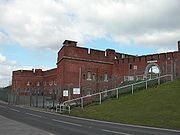
Fort Southwick
Encyclopedia

Portsdown Hill
Portsdown Hill is a long chalk hill in Hampshire, England, offering good views over Portsmouth, The Solent, Hayling Island and Gosport, with the Isle of Wight beyond. The hill is on the mainland, just to the north of Ports Creek, which separates the mainland from Portsea Island, on which lies the...
, which overlooks the naval base of Portsmouth
Portsmouth
Portsmouth is the second largest city in the ceremonial county of Hampshire on the south coast of England. Portsmouth is notable for being the United Kingdom's only island city; it is located mainly on Portsea Island...
in the county of Hampshire
Hampshire
Hampshire is a county on the southern coast of England in the United Kingdom. The county town of Hampshire is Winchester, a historic cathedral city that was once the capital of England. Hampshire is notable for housing the original birthplaces of the Royal Navy, British Army, and Royal Air Force...
, England
England
England is a country that is part of the United Kingdom. It shares land borders with Scotland to the north and Wales to the west; the Irish Sea is to the north west, the Celtic Sea to the south west, with the North Sea to the east and the English Channel to the south separating it from continental...
. It is the highest fort on the hill, and holds the water storage tanks for the other forts, supplying them via a brick lined aqueduct
Aqueduct
An aqueduct is a water supply or navigable channel constructed to convey water. In modern engineering, the term is used for any system of pipes, ditches, canals, tunnels, and other structures used for this purpose....
. Construction was started in 1861 and completed by 1870. It was designed to house a large complement of men (about 220) in a crescent-shaped barrack block. Its north projection has one full caponier
Caponier
A caponier is a type of fortification structure. The word originates from the French word "caponnière" - which strictly means capon-cote i.e. chickenhouse.The fire coming from the feature A caponier is a type of fortification structure. The word originates from the French word "caponnière" -...
to defend the dry ditch, and has two smaller demi-caponiers at the corners. A small musket
Musket
A musket is a muzzle-loaded, smooth bore long gun, fired from the shoulder. Muskets were designed for use by infantry. A soldier armed with a musket had the designation musketman or musketeer....
ry gallery crosses the ditch at the south-west angle to cover a minor branch of the ditch. Mortar batteries of five mortars each can be found set into the rampart behind the demi caponiers.
In 1893 the fort was armed with a total of 23 guns:
- Nine 64 lb (29 kg) rifled muzzle loaders
- Eight 7 in (175 mm) rifled breech loaders
- Six 8 in (20 cm) rifled muzzle loaded howitzers (three were on ground platforms; the other three on traveling carriages)
A central spiral staircase from the surface gives access to four main tunnels running radially outward from it at uneven angles. These tunnels lead to the barrack block and caponiers, and past the magazine.
The communications "nerve centre", Underground Headquarters or UGHQ, for Operation Overlord
Operation Overlord
Operation Overlord was the code name for the Battle of Normandy, the operation that launched the invasion of German-occupied western Europe during World War II by Allied forces. The operation commenced on 6 June 1944 with the Normandy landings...
was in a secret network of tunnels located 100 ft (30 m) underneath Fort Southwick during the Second World War, well out of reach of any bombs of the era. The call sign of this base was 'MIN'.
Although disarmed in 1906, the fort was retained by the military as a barracks
Barracks
Barracks are specialised buildings for permanent military accommodation; the word may apply to separate housing blocks or to complete complexes. Their main object is to separate soldiers from the civilian population and reinforce discipline, training and esprit de corps. They were sometimes called...
, and also used to train soldiers how to capture and hold a fort. It became a demobilisation centre for three years after the First World War. The fort was part of the Admiralty Research Establishment until 2002, when all operational use of the fort ceased. It was sold by the Ministry of Defence
Ministry of Defence (United Kingdom)
The Ministry of Defence is the United Kingdom government department responsible for implementation of government defence policy and is the headquarters of the British Armed Forces....
in July 2003 to the "Fort Southwick Company Limited", who intend to convert the barrack block into luxury apartments.

